Alexey Stavitsky
Engineers, intelligence officers, and futurists: how science and cutting-edge art came together to produce synthesizers in the Soviet Union
At V–A–C Sreda’s request, Alexey Stavitsky has compiled a concise guide to Soviet experiments in electronic sound, whose echoes are still audible in today’s music.
The industrial era required a new aesthetic language — and a new sound: hence the search for synthetic sound, which dates to the early twentieth century. The quest to design the first synthesizers began in the mid-nineteenth century, but the first instruments were so peculiar or bulky (such as Thaddeus Cahill’s Telharmonium, weighing a staggering 200 tons) that they were not widely used in the early decades of the twentieth century. The main obstacle, however, was the mental willingness not only to employ new timbres, but also to make the breakthrough to a fundamentally different kind of music.
There was a clear conception of radical experimentation in Russia even before the Revolution: take, for example, Nikolai Kulbin, the founder of the Stray Dog Cabaret in Petersburg, a significant mover and shaker, patron of the arts, and artist associated with the likes of Nikolai Evreinov, Vsevolod Meyerhold, Mikhail Matyushin, and Elena Guro. Kulbin (1909) wrote, “Like the nightingale, the free music artist is not restricted to tones and semitones. He uses both quarter tones and octaves, and music whose sounds are freely chosen.” In fact, Kulbin’s pamphlet Free Music was one of the earliest manifestos of avant-garde music, reflecting fatigue with the tempered structure of European musical composition and showing the way forward to new methods: “You can convey the voice of a loved one, the song of a nightingale, the murmur of greenery, the gentle or stormy noise of wind and sea. It is possible to depict the stirrings of the human soul more fully” (Kulbin 1909). During the same period, Alexander Scriabin expanded the idea of harmony, nurturing his own version of a synthesis of arts by combining sound and color in such works as The Poem of Ecstasy and Prometheus: The Poem of Fire. Vladimir Baranov-Rossiné’s optophone thundered forth as early as 1916 at international exhibitions. His light-and-music piano can be safely called the prototype of modern DVJ turntables and multimedia installations.

All photos are taken from open sources.
It is telling, however that the music for Victory Over the Sun, the key opera in the history of Russian Futurism, was composed by Matyushin, who combined a recording of an out-of-tune piano, a running motor engine, a cannonade, and a discordant chorus of university students in his score. In his article “The Theater, ” Malevich (2004) wrote, “Matyushin’s sound shattered the sticky, applause-greased bark of the old music, while Alexei Kruchenykh’s lyrics and letter-sounds atomized the material word. The curtain was torn, tearing at the same time the wail of the old brain’s consciousness, revealing to the eyes of the frenzied crowd the roads jutting into earth and sky alike. We have blazed a new trail to the theater.”
Interdisciplinarity — an original and fruitful trait—was one of the hallmarks of the Russian musical avant-garde.
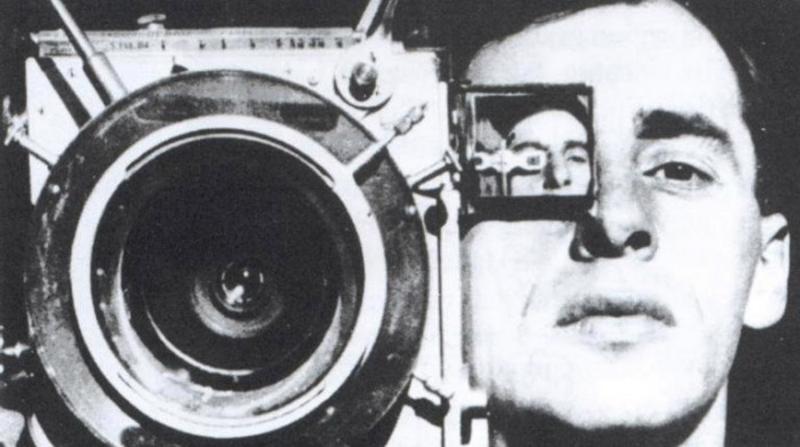
For example, Dziga Vertov, the famous experimental film director, is much less known as a composer, and yet it was he who pioneered the technique of so-called field recordings. “I had an idea about the need to expand our ability to hear in an organized way, to not limit this capacity to ordinary music. I included the entire audible world in the concept of hearing. My experience of recording the sounds at a sawmill dates to this period” (Vertov 2008). With the advent of sound cinema, Vertov shifted his experiments to the new medium: using the first mobile film camera (specially designed for him by the inventor Alexander Shorin, it weighed more than a ton), he recorded the legendary noise score for the film Enthusiasm: The Symphony of the Donbass (1930). “Never had I known that these mechanical sounds could be arranged to sound so beautiful. I regard it as one of the most exhilarating symphonies I have heard. Mr. Dziga Vertov is a musician. Professors should study with him and not argue, ” Charlie Chaplin said of the outcome (Smirnov 2013: 167).
It was during this same period that Vladimir Popov, the inventor of whole orchestras of sound effects devices for the theater, was incredibly prolific, devising instruments and machines that could reproduce the trampling of hooves, thunderstorms, wind, rain, roaring crowds, and the rumble of tank tracks.
Popov moved from the theater to a job as head sound effects engineer at Mosfilm Studios. The cinema was universally fascinated with “noise scores”: they were employed by Sergei Eisenstein, Vsevolod Pudovkin, and Mikhail Romm, who gleaned the rhythms and timbres of the big city, the sounds of factories, roads, and cars. As Romm (1982) recalled, “We did incredible experiments with sound. […] The music had to be accompanied by sound effects and emerge from them. […] The most complex score would be written, divided into frames bar by bar; the rhythm was laid down exactly with a metronome. Then I had to edit these cut-up pieces of music, speech, and noise into a single whole. It was a work of unthinkable complexity. […] Moreover, [Vladimir] Popov developed a sound effects symphony for us. Dozens of sound effects technicians rattled, clanked, whistled, barked, buzzed, and tinkled various pieces of wood and iron.”
This variety of “proto-industrial” music was popular in the cinema, theater, and symphonic music of the 1920s. We can recall Alexander Mosolov’s Factory: Machine Music (aka Iron Foundry) (1926–27) and The Dam (1930), Vladimir Deshevov’s Rails (1926), Sergei Prokofiev’s The Steel Step (1925–26), and Dmitry Shostakovich’s The Bolt (1930–31), in which the motifs of machinery and industry were musically imagined in different ways and quantities.
The forward-looking era’s background noise is extremely important for understanding the context in which electronic music emerged in the Soviet Union. An interest in innovation, an emphasis on the search for new forms, and the young Soviet state’s experiments in theory and practice pushed not only artists, but also scientists, engineers, and inventors to design unprecedented devices and machines.
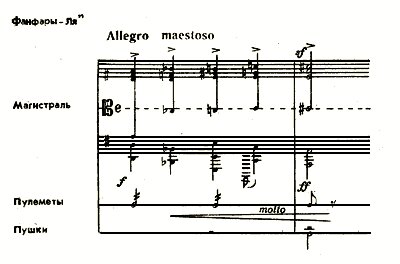
One of the most striking works of the 1920s was Arseny Avraamov’s Symphony of Sirens (1922), in which the composer replaced classical instruments with train whistles, steamship horns, factory sirens, and airplane noise, and machine guns and artillery served as percussion. The symphony was performed in Nizhny Novgorod, Baku, and Moscow. The very image of a train traveling and playing at the same time (as Avraamov wanted to explore in his “topographical acoustics” project) suggests parallels with modern network culture. Few people at the time worked as boldly with space, the masses, the avant-garde, and machinery, as Avraamov did.
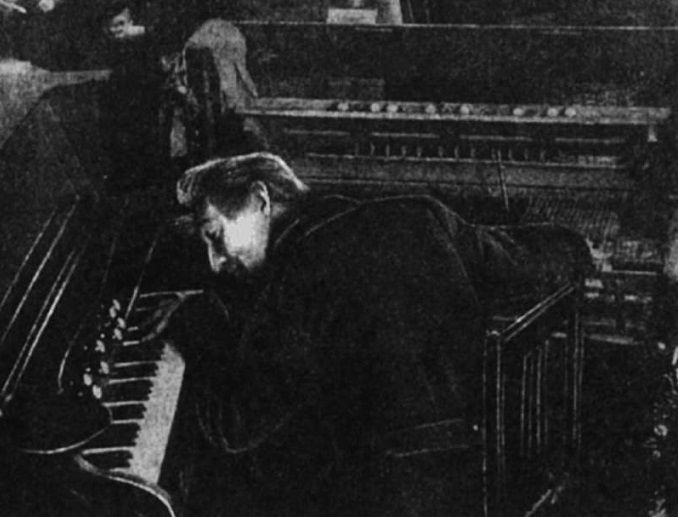
Avraamov is a unique and important figure in Russian cultural history. A revolutionary and a man with many pseudonyms (aka Revarsavr, Dmitry Donskoi, Arslan Ibrahim-ogly Adamov, Axel Smith, Ars, and Regent), a sailor, polygamist, eccentric, music critic, polemicist, political journalist, theorist, acoustician, folklorist, and inventor of his own 48-tone system, Avraamov advocated destroying tonal music and burning all grand pianos (“they have spoiled humanity’s sense of hearing”). Dreaming of fusing science and art, he founded the Leonardo da Vinci Society, which gave birth to “graphical sound” and breakthrough portable synthesizers.
However, the first was Leon Theremin. His life was like a novel within a novel. A physicist, engineer, inventor, and future NKVD officer, Theremin in 1920 introduced the world to the theremin (aka thereminvox), the world’s first full-fledged concert synthesizer, which was born as a byproduct of a device invented for studying the properties of gases. It was the first that an electrical musical device had been designed to be so compact and convenient; moreover, it was controlled not with an ordinary keyboard, but by the performer’s moving his hands. The instrument has two antennas (one for pitch, the other for volume control), and between them lies an electromagnetic field inside which performers can play intuitively with their hands. Theremin’s revolutionary approach to design wholly echoed Soviet state policy. The campaign to electrify the Soviet Union was widely covered: Lenin himself gave a thumbs-up to the theremin, and Theremin even traveled around country with the new instrument as a propagandist for the State Commission for the Electrification of Russia (GOELRO).
You do not need to touch the theremin to play it. Instead, you correlate the position of your hands vis-à-vis the instrument, relying only on your ear to guide you.
Although playing the theremin is not as easy as it seems from the outside, it quickly became clear that the instrument was universal: it can imitate the sounds of outer space, and the singing of birds, and the screech of a whistle. It has been mass-produced for a hundred years, and in fact needs no upgrades. It has been used in cinema, theater, and the circus. It has been heard across the entire spectrum of the musical world, from Led Zeppelin, the Rolling Stones, Sting, the Pixies, and Erykah Badu to Miklós Rózsa (he used the instrument in his score for the Alfred Hitchcock film Spellbound), Jean-Michel Jarre, and the Russian rock group Mumiy Troll. Theremin-like instruments have been used even more widely: the most famous example is Paul Tanner’s Electro-Theremin, heard in the Beach Boys’ smash hit “Good Vibrations.”
The theremin gained worldwide success in the 1920s, and Theremin moved to the United States, while retaining his Soviet citizenship. According to one version, even at this early stage he had been recruited by Soviet intelligence and, as an immensely popular person in the United States, he carried out espionage work under the cover of his scientific endeavors.
In the United States, Theremin met the African-American dancer Lavinia Williams, and their romance resulted in a new instrument — the terpsitone, a version of the theremin that, as a kind of synthesizer for dancers, was controlled by the entire body. In 1932, Theremin invented the rhythmicon, the world’s first drum machine. The rhythmicon was designed to produce almost any rhythmic structure. It featured keys, disk speed controls, a photo sensor with amplifiers, its own light sources, and rotating disks with holes. The pitch disk was responsible for the constant signal, while the time disk was responsible for the rhythmic pattern. The frequency of the signal depended on the disk’s rotation speed and the number of holes through which the light penetrated.
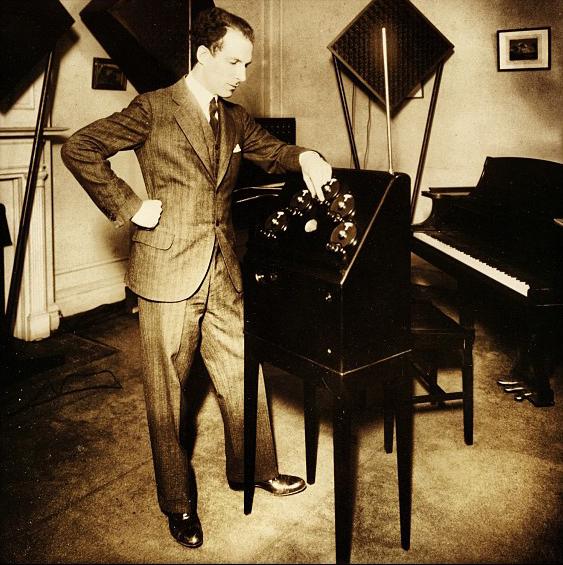
In his lectures and performances, Theremin spoke of a new music that would incorporate color, gesture, smell, and touch.
In 1938, Theremin returned to his homeland, where he was accused of conspiring to murder Sergei Kirov and sent to a prison camp in Magadan for eight years. There he found himself in the legendary Tupolev sharashka, where he worked with Sergei Korolev on designing drones. It was in Magadan that Theremin invented the Buran eavesdropping system, for which he was awarded a state prize and released from prison. The Buran contained special microphones that recorded the vibration of glass and transmitted the signal to headquarters. The Buran was involved in a legendary episode in 1945: at the celebration of the Artek Young Pioneer camp’s twentieth anniversary, the American ambassador was presented a large wooden replica of the US seal, which was hung in his office after it was vetted. Theremin’s latest design was hidden inside the seal, however: the battery-less Chrysostom endovibrator (aka The Thing), which could not be detected. For eight years, it transmitted information to Soviet intelligence. What a great page this was in the history of world electronic music and electroacoustics!
In the 1960s, Theremin left the KGB and worked at the Moscow Conservatory before taking a job as a simple mechanical engineer at the physics department of Moscow State University, where he continued his experiments, albeit with much less publicity. He was visited by Robert Moog and Brian Eno. In perestroika-era Russia, few people remembered Theremin, although he had long been famous in the west as the world’s first electronic musician. In his final years, Theremin worked at Moscow State University, where he had been reinstated as a professor, despite the loss of documents certifying his scholarly degrees. He died in 1993 at the age of ninety-seven. According to memoirs of his contemporaries, when people remarked on his age, Theremin joked that his last name should be read backwards.
Using Theremin as an example, we have returned to the encounter between science and electronic music. Moreover, Theremin’s famous musical instrument served as a prototype when he designed proximity sensors and alarm systems: when a certain area covered by the antenna was crossed by a moving body, the devices emitted an audible signal.
However, in addition to such stars as Theremin, there were also lesser known but no less significant designers whose lives are part of the secret history of Russian electronic music, a history that has yet to be explored.
Off the beaten track was Nikolai Obukhov’s croix sonore (sonorous cross). Obukhov was an émigré to France, a student of Maurice Ravel, and a mystical composer. His instrument was essentially a copy of the theremin, but it was designed in a way that invoked religion and mysticism. The croix sonore consisted of a cross, planted on a globe; the center of the cross contained a star.
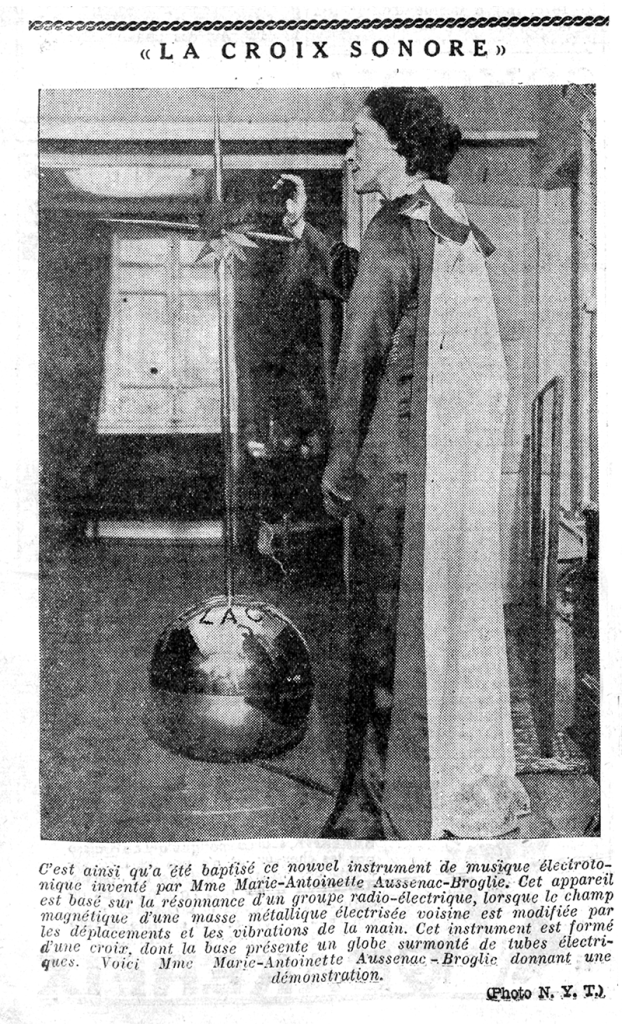
The Sonar of Nikolai Ananyev (1933) was also similar to the theremin, with the difference that instead of antennas it had a fingerboard that allowed musicians to alter timbre and pitch by sliding their fingers over it.
A professional designer and specialist in musical psychology, Andrei Volodin designed the innovative Ekvodin (1937). The device was unique for its era: with a range of six and a half octaves, it featured a multitude of timbres, as well as presets for imitating all the instruments in a symphony orchestra. A group of five Ekvodins even surpassed the capacities of a 27-piece orchestra. The synthesizer was equipped a modulation pedal and a keyboard that enabled musicians to produce vibrato effects as on traditional stringed instruments. Using knee levers, plays could also control attack and attenuation. Only ten copies were produced: the instrument weighed almost forty kilograms, and the entire setup, featuring a speaker system, weighed up to seventy kilograms, and thus was never mass-produced. Nevertheless, Shostakovich was a fan of the instrument, and the Ekvodin can be heard on the soundtracks of many Soviet films, such as The Ballad of Siberia (1948) and Amphibian Man (1962).
All these examples would seem to be the fruit of isolated experiments, but there is also a vector in the evolution of Russian synthesizers that, if we look closely, turns out to be absolutely continuous — this is the history of so-called graphical sound.
In 1917, one of the forgotten heroes of Russian electronica, inventor Yevgeny Sholpo, wrote a science fiction essay titled “The Enemy of Music” in which he described a sound machine named the “Mechanical Orchestra, ” capable of producing music without a performer. In fact, Sholpo accurately described the ANS synthesizer, which would be built forty years later. In 1929, Sholpo, along with Avraamov and the animator Mikhail Tsekhanovsky, produced a soundtrack for Abram Room’s film The Plan for Great Works (1930). They came to an amazing discovery: they could draw music directly on the filmstrip, and it was audible! As Avraamov (1939) later recalled:
We looked with great interest through a magnifying glass at the first, still wet, soundtrack, just delivered from the developing room. After finishing the picture, each of us tried to implement the discovery in his own way. Tsekhanovsky admired the beauty of ornamental curving patterns and fantasized: ‘I wonder whether, if we recorded an Egyptian or ancient Greek ornament on this track, hitherto unknown archaic music would start playing? ’ My initial experiment was demonstrated at the first national sound cinema conference. It was a rather successful imitation of a hurdy-gurdy playing, in funny harmonies, the famous song “Marusya Poisoned Herself, ” which I had once recorded in the field. The simple texture, the deliberate lack of nuance, and the blatantly husky timbre made the task easier and increased the effect of realism, which, I must say, was amazing. Sholpo tried to mechanize the process by recording dynamically, in continuous motion, on a special device he invented—the Variophone We took the timbre colors readymade from Euclidean geometry: triangles, trapezoids, squares, semicircles, etc. Sholpo tried to ‘synthesize sine waves’ in a strictly scientific way. We immediately switched to searching for new ‘unheard’ timbres, new tonal systems, and complex polyrhythmic effects.
The evolution of electronic music in Russia was thus tightly bound up with graphical art and animation.
In the late 1920s, graphical sound studios emerged in Moscow and Leningrad, and in 1931 Sholpo demonstrated the Variophone, an electric musical instrument that was the first prototype of an optical sampler.
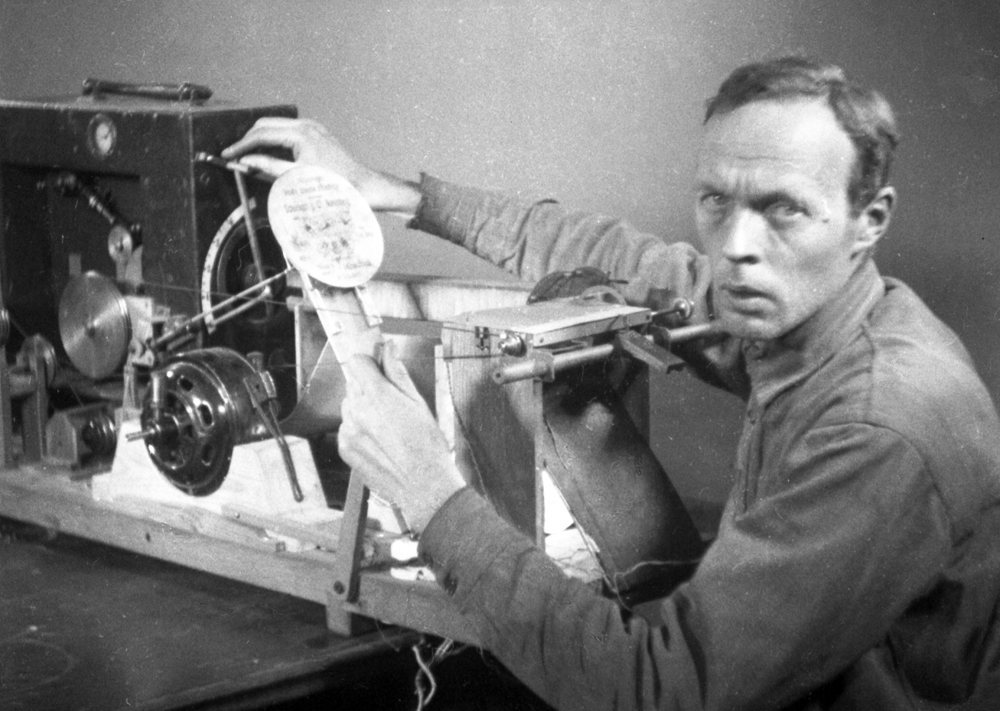
The Variophone could be described as a film camera with an electric motor pulling the film. Unlike Avraamov’s “ornamental sound, ” Sholpo’s technology did not include an animation stand. An intermittent beam of light produced an outline of the sound directly on the filmstrip. Sholpo cut the shapes of sound waves onto special cardboard discs. The Variophone would read them, synthesizing them into music reminiscent of the 8-bit sound of early computer games.
In addition to engineering supremely innovative technology, Sholpo was able to produce polyphonic soundtracks (featuring as many as twelve voices simultaneously), obtain such effects as glissando and vibrato, and simulate a wide variety of rhythms. Unfortunately, the Variophone was destroyed during Siege of Leningrad, but we still have a few animated films featuring graphical sound and approximately an hour and a half of Variophone recordings.
The fate of Avraamov’s archive was even more tragic: when, in 1936, the composer traveled to the Caucasus to research the local folk music, his children in Moscow burned almost two thousands meters of film, making smoke bombs out of the footage.
In 1931, the animator and cameraman Nikolai Voinov, who was a member of Avraamov’s Multzvuk Group, experimented with his own tool, the Nivotone: the soundtrack was photographed frame by frame on an animation stand and then combined with the visual track.
Voinov produced eighty-seven templates, containing shapes corresponding to all the semitones on the piano. The lower the tone, the wider the distance between the shapes. The pitch correlated with the size of the shapes and their frequency. These shapes were combined to produce the “paper sound” of the animated shorts Lady (1931), Rachmaninoff’s Prelude (1932), The Dance of the Crow (1933), Color Fields (1934), and The Thief (1934), some of which are still extant.
The outstanding acoustician Boris Yankovsky focused on synthesizing timbres, conducting a thorough investigation of the methods of spectral analysis, decomposition, and re-synthesis. In 1933, Yankovsky launched the Laboratory of Synthetic Sound Recording at Mosfilm Studios, where he recorded 110 “syntones, ” based on samples of instruments from the Bolshoi Theater Symphony Orchestra. By studying in detail the frequency of sounds (i.e., their brightness and color), Yankovsky was, in fact, pursuing the additive sound synthesis method that would be applied in computer-aided composition only in the 1980s (e.g., spectral music, the analogue of modern time stretching algorithms, etc.). It was Yankovsky who mentored the young inventor Yevgeny Murzin, designer of the legendary ANS synthesizer, which only seems out of place in the 1950s. In fact, the ANS was related to the optical designs of the 1930s, and it could have been invented twenty years earlier.
In the mid-1930s, however, the Soviet authorities launched a campaign against “formalism” in the arts (as typified by the Pravda article “Confusion Instead of Music, ” vilifying Shostakovich): the laboratories were closed, and the war began soon thereafter. Without no support or team, Murzin pursued the ideas of Sholpo and Yankovsky alone, implementing a project to build a powerful photoelectronic machine that would translate images into sound while avoiding the lengthy processes of shooting, developing, and drying film.
Murzin’s circumstances were somewhat similar to those of Theremin in the late 1930s. Murzin designed the synthesizer in his spare time, using his own money, while living in a communal apartment. During the war, Murzin developed methods and devices for targeting air defense artillery, after which he became a chief designer for the Soviet air force. As a big fan of Alexander Nikolaevich Scriabin (which is what ANS stands for), Murzin refused, during these long years, to abandon his idea of combining light and sound. His new instrument was supposed to help composers produce any sound or tone they wished.
ANS performers and composers are more like visual artists. Instead of the usual keys, they confront a glass plate covered with a layer of non-drying opaque black mastic. By deleting, retouching, and tinting this drawing surface, they can synthesize the most incredible sounds. A beam of light passing through special disks records the score. 720 tracks of pure tones, the ability to create previously unknown voices and noises, to change vibration, timbre, and tempo, and to add effects, while recording and playing entire parts: all of it looked and sounded amazing in 1957. The ANS was installed in the Scriabin Museum in Moscow, where Murzin established an electronic music studio. The now-famous composers Alfred Schnittke, Sofia Gubaidulina, Edison Denisov, Vladimir Martynov, and Stanislav Kreichi worked at the studio, experimenting with the ANS, and making recordings.
Although the major Soviet recording company Melodiya delayed releasing certain ANS albums (such as Musical Offering, featuring works by the above-mentioned composers) for almost twenty years, the ANS’s recognizable sound was already making its way into the masses in the 1970s. Shortly before his death in 1970, Murzin convinced Melodiya to release electronic music on vinyl. The most significant compilation records of the period were ANS and Metamorphoses.
The young Eduard Artemyev also took part in these experiments. Although surprising, it is a fact that the early twentieth-century Russian avant-garde has come down to us via its electronica as well. After all, it was Murzin who hired Artemyev to work at “Mailbox 2377,” a classified military institute that dealt with missile defenses. So even before the Scriabin Museum studio opened, Artemyev had been exposed to the unique ANS virus, according to his own account, and it changed his life. Artemyev made the ANS’s outer-space sound widely known first in the Soviet Union, and then in the world, using the synthesizer in his scores to the Andrei Tarkovsky films Solaris, Mirror, and Stalker. As Artemyev recalled in an interview,
Tarkovsky said that for a picture like Solaris what he needed was not a composer, but a composer’s ear—to orchestrate the sound effects. And not just to orchestrate them, but to breathe life into them. We had a chat and went our separate ways. . . When filming started, he called me again and asked me to watch the rushes. When we came to the famous shot of seaweed swaying in a stream, he said, “There will be the sound of a stream here. But I need something that subconsciously attracts attention to make these shots memorable, to give them a sense of human warmth.”
The ANS’s amazing capacities were perfectly revealed in “scoring” outer space, in creating ambient abstract canvases for Soviet sci-fi films and auteur cinema. The synthesizer can also be heard in tremendously popular Soviet films (e.g., The Diamond Arm and Siberiade) and animated films (e.g., Adventures of Mowgli). Unfortunately, the ANS was never put into mass production and, by the 1960s, it faced competition from more compact western models. After Murzin’s death, the ANS was used to study the language of dolphins, but this research is still classified as top secret. In 2002, the British band Coil recorded an album on the ANS in the basement of Moscow State University, and they were followed in 2005 by the Italian project Bad Sector.
The interdisciplinarity undergirding the unique history of Soviet synthesizers comes to the fore: not only did musicians and designers themselves played a leading role in it, but they were joined by filmmakers, animators, physicists, military engineers, and even secret services officers. Many facts and details of this story have long been gathering dust in the archives — films were shelved, instruments were destroyed, and experiments were hushed up. Now it is obvious that, in the early 1930s, Soviet designers were able to sample and synthesize the sounds of classical instruments, the human voice, and different sound effects. The earliest sequencers, drum machines, and polyphonic synthesizers emerged, and they were used to score live-action and animated films.
We encounter the ideas of early Soviet electronica in our own time: Yankovsky, in fact, invented additive synthesis, Theremin built the drum machine, and Murzin designed the prototype of the modern piano roll sequencer. Interactivity, coding, and the use of algorithms in music: we find the prototypes of these trends in the thoughts and inventions of Soviet engineers. As the mad genius Avraamov prophesied in 1925: “If we lack the sonority of factory horns, what, I repeat, shall we dream of? It is clear: a Theremin or Rzhevkin device installed on an aeroplane gliding over Moscow. An aero-radio-symphony! We’ll hear it again, anyway!”
Translated, from the Russian, by Thomas H. Campbell
Bibliography
Anfilov, Gleb (1962). Fizika i muzyka [Physics and music]. Moscow: Detgiz.
Avraamov, Arsenii (1939). “Sinteticheskaia muzyka” [Synthetic music]. Sovetskaia muzyka 8.
Egorova, Tat’iana (2006). Vselennaia Eduarda Artem’eva [Eduard Artemyev’s universe]. Moscow: Vagrius.
Eizenshtein, Sergei (1998). Montazh [Montage]. Moscow: VGIK.
Ivanov-Vano, Ivan (1980). Kadr za kadrom [Frame by frame]. Moscow: Iskusstvo.
Kul’bin, Nikolai (1909). Svobodnaia muzyka. Premenenie novoi teorii khudozhestvennogo tvorchestva k muzyke [Free music: applying a new theory of artistic creativity to music]. Saint Petersburg: Voennaia tipografiia.
Malevich, Kazemir (2004). “Teatr” [The theater]. Sobranie sochinenii v 5 tomakh, vol. 5. Moscow: Gileia.
Murzin, Evgenii (2008). ANS. U istokov elektronnoi muzyki [ANS: at the origins of electronic music]. Moscow: Kompozitor.
Romm, Mikhail (1982). “Obiazan svoei kar’eroi v kinematografe [I owe my career in cinema]. Izbrannye proizvedeniia. Moscow: Iskusstvo.
Smirnov, Andrey (2013). Sound in Z: Forgotten Experiments in Sound Art and Electronic Music in Early 20th Century Russia. London: Sound & Music/Koenig Books.
Vertov, Dziga (2008). “Kak eto nachalos’?” [How did it begin?]. Iz naslediia, vol. 2: Stat’i i vystupleniia. Moscow: Eisenstein Center.
sreda@v-a-c.org
All rights reserved. Reproducing or using the materials from this web-page without written consent of the rightsholder is forbidden.